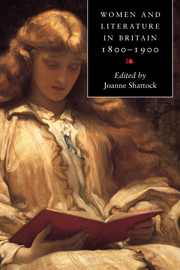Book contents
- Frontmatter
- Contents
- List of contributors
- Acknowledgments
- Chronology
- Introduction
- 1 The construction of the woman writer
- 2 Remaking the canon
- 3 Women and the consumption of print
- 4 Women writing woman: nineteenth-century representations of gender and sexuality
- 5 Feminism, journalism and public debate
- 6 Women's writing and the domestic sphere
- 7 Women, fiction and the marketplace
- 8 Women poets and the challenge of genre
- 9 Women and the theatre
- 10 Women writers and self-writing
- 11 The professionalization of women's writing: extending the canon
- 12 Women writers and religion
- 13 Women writing for children
- Guide to further reading
- Index
13 - Women writing for children
Published online by Cambridge University Press: 03 October 2009
- Frontmatter
- Contents
- List of contributors
- Acknowledgments
- Chronology
- Introduction
- 1 The construction of the woman writer
- 2 Remaking the canon
- 3 Women and the consumption of print
- 4 Women writing woman: nineteenth-century representations of gender and sexuality
- 5 Feminism, journalism and public debate
- 6 Women's writing and the domestic sphere
- 7 Women, fiction and the marketplace
- 8 Women poets and the challenge of genre
- 9 Women and the theatre
- 10 Women writers and self-writing
- 11 The professionalization of women's writing: extending the canon
- 12 Women writers and religion
- 13 Women writing for children
- Guide to further reading
- Index
Summary
Along a cool sequestered way,
Her quiet walk she winds;
Sheds milder sunshine on his day,
His brow with flowers binds.
Of art intuitive possest,
Her infant train she rears;
To virtue by her smiles carest,
Or chastened by her tears:
Beside the flitting midnight lamp,
With fond and wakeful eye,
Wipes gently off the dying damp,
Or sooths the parting sigh: –
'Tis here that Woman brightest shines
(Though bright in other spheres):
Her name is drawn in fairest lines,
When written by her tears.
Yet not the weak, the puny thing,
Subdued to silly woe;
The firmest dignity may spring,
Where softest feelings grow.
From ‘Remonstrance’ by Ann Taylor Gilbert (1807)INTRODUCTION
In a century that defined the role of the ‘proper’ woman as the care of her home and the monitoring of the spiritual and physical welfare of the family, (literate) women often wrote for children, whether privately (through homemade primers, stories, poems and instructive correspondence) or through publication. As nursery monitors, moral arbiters and domestic managers – whether mothers, spinster aunts or maiden daughters, and even as they perhaps worked beside their husband or brothers in trade, or headed households – women were responsible for bringing up the next generation. Middle-class girls were trained in this ideology of ‘woman's mission’ from a very young age, and numerous instructive books on ‘professional motherhood’ existed to guide them. One typical text of this type is Practical Hints to Young Females on the Duties of a Wife, a Mother and a Mistress of a Family (1815), by Ann Martin Taylor, mother of poets Ann and Jane Taylor.
- Type
- Chapter
- Information
- Women and Literature in Britain 1800–1900 , pp. 275 - 300Publisher: Cambridge University PressPrint publication year: 2001

